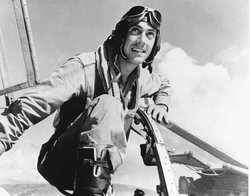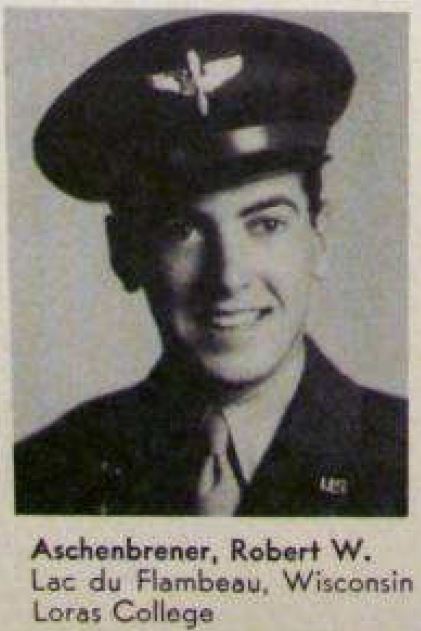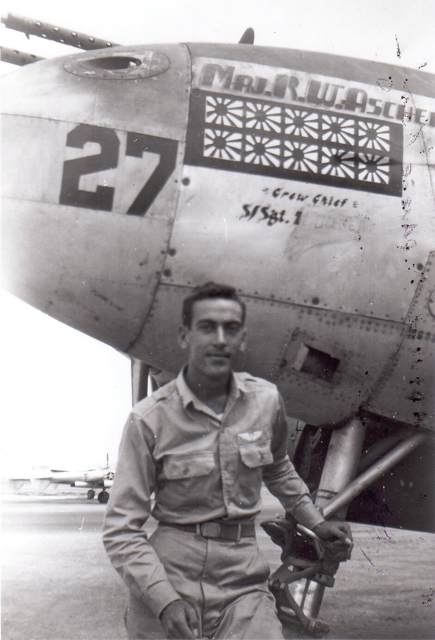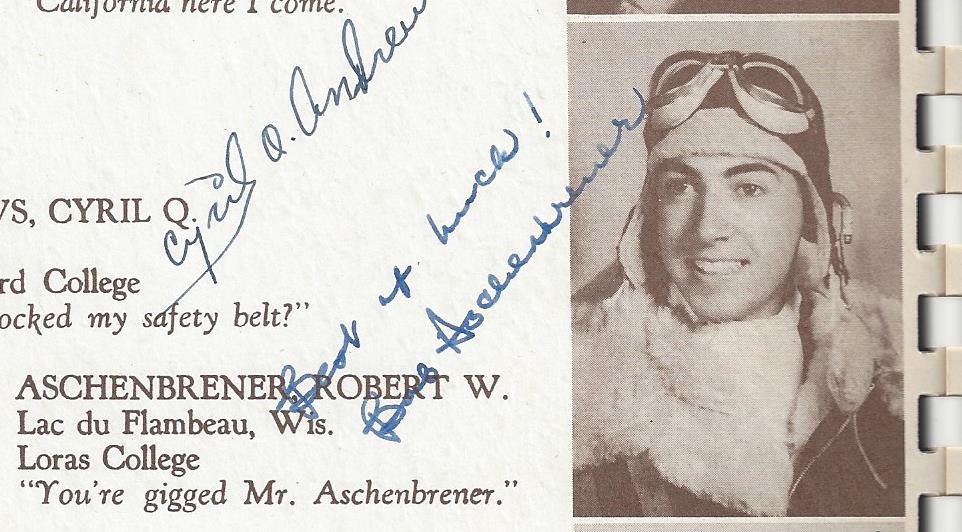Robert Wayne Aschenbrener was born on 22 November 1920 in Fifield, WI, the son of George B. and Marietta Aschenbrener. He was raised on the Indian reservation at Lac du Flambeau, WI, and, after graduation from high school, he attended Loras College in Dubuque, IA, for two years. In September 1941, he enlisted as an Aviation Cadet in the U.S. Army Air Corps and received flight training at the following Texas locations: Kelly Field in San Antonio; Bruce Field in Ballinger; San Angelo Army Air Field in San Angelo; and Moore Army Air Field in Mission. He graduated in 1942 with the Class of 42H and was commissioned as a Second Lieutenant in the U.S. Army Air Corps with the rating of Pilot.
2LT Aschenbrener was assigned to the 8th Fighter Squadron (Black Sheep Squadron), 49th Fighter Group, then based in New Guinea. With the Curtiss P-40 Warhawk he scored his first 2 victories in aerial combat on 15 November 1943, followed by a 3rd victory on 15 February, 1944. After a promotion to Captain, he was assigned as Operations Officer and flew 272 more combat missions. In the summer of 1944, he was sent to the U.S. to instruct pilots in fighter tactics.
Bored with flight instruction and wanting to return to combat, CPT Aschenbrener talked his superiors into a trip back to his old unit, which was now flying the Lockheed P-38 Lightning in the Philippines. Assigned again as Operations Officer, on 24 November 1944, he became an ace by downing 3 Kawasaki Ki-61s (Tony's) and 1 Mitsubishi A6M Zero (Zeke) in a single mission. His unquestionable valor and flying skills in aerial combat that day earned him the U.S. Army's second highest award for valor, the Distinguished Service Cross. On 11 and 14 December 1944, he was credited with his 9th and 10th aerial victories.
While on a strafing run on enemy-occupied Clark Field on Christmas Day 1944, Aschenbrener's P-38 was hit by 20mm ground fire, and he crashed into a rice paddy barely 5 miles from the end of the runway. Picked up by Huk guerrillas, he hid in the jungle for nearly a month while evading enemy troops looking for him. During this time he was joined by the crew of a Navy torpedo plane, as well as downed F-6F Hellcat ace, Alexander Vraciu. Making it back to safety after 27 days on the run, he returned to his unit. Aschenbrener received a promotion to Major and was given command of the 7th Fighter Squadron, 49th Fighter Group.
During this time, he met his soon-to-be wife, Laura Ann Middleton. On 20 August 1945 they were married on the recaptured Clark AFB in the shadow of Mount Pinatubo (a volcano that eventually destroyed Clark AFB) just a few miles from where his plane went down.
When he left the Army Air Force in September 1945, Major Aschenbrener had flown 345 combat missions, over 850 combat hours, and had downed 10 aircraft in aerial combat flying P-40, P-47, and P-38 fighter aircraft.
Civilian Life
In September 1945, Aschenbrener left military service to pursue a degree in Journalism at the University of Missouri at Columbia, MO. Robert and Ann then set about raising a family of four sons and four daughters in the states of Ohio, Texas and California. After retiring from the Los Angeles Valley News, Robert and Ann moved to Cameron Park in northern California.
Medals, Awards and Badges
Distinguished Service Cross
Distinguished Flying Cross with Silver Oak Leaf Cluster
Purple Heart
Air Medal with Award Numeral 9
Army Good Conduct Medal
American Defense Service Medal
Asiatic-Pacific Campaign Medal
World War II Victory Medal
Presidential Unit Citation with 2 Bronze Oak Leaf Clusters
Army Air Force Pilot Badge
Distinguished Service Cross Citation (Synopsis)
Captain (Air Corps) Robert Wayne Aschenbrener (ASN: 0-664120), United States Army Air Forces, was awarded the Distinguished Service Cross for extraordinary heroism in connection with military operations against an armed enemy while serving as Pilot of a P-38 Fighter Airplane in the 8th Fighter Squadron, 49th Fighter Group, FIFTH Air Force, in aerial combat against enemy forces on 24 November 1944, over the Philippine Islands. On this day Captain Aschenbrener shot down FOUR enemy aircraft in a single mission. His unquestionable valor in aerial combat is in keeping with the highest traditions of the military service and reflects great credit upon himself, the 5th Air Force, and the United States Army Air Forces.
General Orders: Headquarters, U.S. Army Forces in the Far East, General Orders No. 99 (1945)
Congressional Gold Medal
The Congressional Gold Medal, created by the U.S. Mint, is the highest civilian honor Congress can give on behalf of the American people. On 20 May 2015, leaders from the U.S. House of Representatives and Senate presented the Congressional Gold Medal to the American Fighter Aces Association at the U.S. Capitol Visitor Center Emancipation Hall.
More than 60,000 American fighter pilots engaged in aerial combat during World War I, World War II, the Korean War and the Vietnam War. Of those pilots, only 1,447 earned the title of fighter "Ace" by downing at least five enemy aircraft. Major Robert Wayne Aschenbrener was one of them, having been credited as a 'Double Ace' with 10 aircraft shot down in aerial combat. At the time of the presentation of the Medal, only 75 of those Aces remained alive.
Honors
Major Robert Wayne Aschenbrener has Honoree Record 311616, with biography, at MilitaryHallofHonor.com.
Robert Wayne Aschenbrener was born on 22 November 1920 in Fifield, WI, the son of George B. and Marietta Aschenbrener. He was raised on the Indian reservation at Lac du Flambeau, WI, and, after graduation from high school, he attended Loras College in Dubuque, IA, for two years. In September 1941, he enlisted as an Aviation Cadet in the U.S. Army Air Corps and received flight training at the following Texas locations: Kelly Field in San Antonio; Bruce Field in Ballinger; San Angelo Army Air Field in San Angelo; and Moore Army Air Field in Mission. He graduated in 1942 with the Class of 42H and was commissioned as a Second Lieutenant in the U.S. Army Air Corps with the rating of Pilot.
2LT Aschenbrener was assigned to the 8th Fighter Squadron (Black Sheep Squadron), 49th Fighter Group, then based in New Guinea. With the Curtiss P-40 Warhawk he scored his first 2 victories in aerial combat on 15 November 1943, followed by a 3rd victory on 15 February, 1944. After a promotion to Captain, he was assigned as Operations Officer and flew 272 more combat missions. In the summer of 1944, he was sent to the U.S. to instruct pilots in fighter tactics.
Bored with flight instruction and wanting to return to combat, CPT Aschenbrener talked his superiors into a trip back to his old unit, which was now flying the Lockheed P-38 Lightning in the Philippines. Assigned again as Operations Officer, on 24 November 1944, he became an ace by downing 3 Kawasaki Ki-61s (Tony's) and 1 Mitsubishi A6M Zero (Zeke) in a single mission. His unquestionable valor and flying skills in aerial combat that day earned him the U.S. Army's second highest award for valor, the Distinguished Service Cross. On 11 and 14 December 1944, he was credited with his 9th and 10th aerial victories.
While on a strafing run on enemy-occupied Clark Field on Christmas Day 1944, Aschenbrener's P-38 was hit by 20mm ground fire, and he crashed into a rice paddy barely 5 miles from the end of the runway. Picked up by Huk guerrillas, he hid in the jungle for nearly a month while evading enemy troops looking for him. During this time he was joined by the crew of a Navy torpedo plane, as well as downed F-6F Hellcat ace, Alexander Vraciu. Making it back to safety after 27 days on the run, he returned to his unit. Aschenbrener received a promotion to Major and was given command of the 7th Fighter Squadron, 49th Fighter Group.
During this time, he met his soon-to-be wife, Laura Ann Middleton. On 20 August 1945 they were married on the recaptured Clark AFB in the shadow of Mount Pinatubo (a volcano that eventually destroyed Clark AFB) just a few miles from where his plane went down.
When he left the Army Air Force in September 1945, Major Aschenbrener had flown 345 combat missions, over 850 combat hours, and had downed 10 aircraft in aerial combat flying P-40, P-47, and P-38 fighter aircraft.
Civilian Life
In September 1945, Aschenbrener left military service to pursue a degree in Journalism at the University of Missouri at Columbia, MO. Robert and Ann then set about raising a family of four sons and four daughters in the states of Ohio, Texas and California. After retiring from the Los Angeles Valley News, Robert and Ann moved to Cameron Park in northern California.
Medals, Awards and Badges
Distinguished Service Cross
Distinguished Flying Cross with Silver Oak Leaf Cluster
Purple Heart
Air Medal with Award Numeral 9
Army Good Conduct Medal
American Defense Service Medal
Asiatic-Pacific Campaign Medal
World War II Victory Medal
Presidential Unit Citation with 2 Bronze Oak Leaf Clusters
Army Air Force Pilot Badge
Distinguished Service Cross Citation (Synopsis)
Captain (Air Corps) Robert Wayne Aschenbrener (ASN: 0-664120), United States Army Air Forces, was awarded the Distinguished Service Cross for extraordinary heroism in connection with military operations against an armed enemy while serving as Pilot of a P-38 Fighter Airplane in the 8th Fighter Squadron, 49th Fighter Group, FIFTH Air Force, in aerial combat against enemy forces on 24 November 1944, over the Philippine Islands. On this day Captain Aschenbrener shot down FOUR enemy aircraft in a single mission. His unquestionable valor in aerial combat is in keeping with the highest traditions of the military service and reflects great credit upon himself, the 5th Air Force, and the United States Army Air Forces.
General Orders: Headquarters, U.S. Army Forces in the Far East, General Orders No. 99 (1945)
Congressional Gold Medal
The Congressional Gold Medal, created by the U.S. Mint, is the highest civilian honor Congress can give on behalf of the American people. On 20 May 2015, leaders from the U.S. House of Representatives and Senate presented the Congressional Gold Medal to the American Fighter Aces Association at the U.S. Capitol Visitor Center Emancipation Hall.
More than 60,000 American fighter pilots engaged in aerial combat during World War I, World War II, the Korean War and the Vietnam War. Of those pilots, only 1,447 earned the title of fighter "Ace" by downing at least five enemy aircraft. Major Robert Wayne Aschenbrener was one of them, having been credited as a 'Double Ace' with 10 aircraft shot down in aerial combat. At the time of the presentation of the Medal, only 75 of those Aces remained alive.
Honors
Major Robert Wayne Aschenbrener has Honoree Record 311616, with biography, at MilitaryHallofHonor.com.
Sponsored by Ancestry
Advertisement
Records on Ancestry
Advertisement








